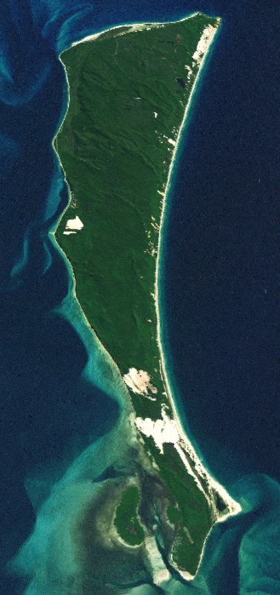Native name: Mulgumpin | |
|---|---|
 Moreton Island satellite image | |
Location of Moreton Island in Queensland | |
| Geography | |
| Location | Coral Sea; Moreton Bay |
| Coordinates | 27°10′S 153°24′E / 27.167°S 153.400°E |
| Area | 186 km2 (72 sq mi) |
| Length | 44 km (27.3 mi) |
| Width | 13 km (8.1 mi) |
| Highest elevation | 280 m (920 ft) |
| Highest point | Mount Tempest |
| Administration | |
Australia | |
| State | Queensland |
| Region | South East Queensland |
| Local government area | City of Brisbane |
| Demographics | |
| Population | 298 (2011 census)[1] |
Moreton Island (Mulgumpin) is an island on the eastern side of Moreton Bay on the coast of South East Queensland, Australia.[2] The Coral Sea lies on the east coast of the island. Moreton Island lies 58 kilometres (36 mi) northeast of the Queensland capital, Brisbane. 98% of the island is contained within a national park and a popular destination for day trippers, four wheel driving, camping, recreational angling and whale watching and a 75-minute ferry ride from Brisbane.[3] It is the third largest sand island in the world.[4] Together with Fraser Island, Moreton Island forms the largest sand structure in the world.[5] It was the traditional country of the Ngugi before settlement.
The island is within the City of Brisbane and is gazetted into four localities, the small townships of Bulwer (on the north-west coast), Cowan Cowan (on the west coast) and Kooringal (on the south-west coast) with the bulk of the island being the locality of Moreton Island.[6] The private Tangalooma Island Resort is also within the locality of Moreton Island. All residential areas are located on the western coast of the island facing Moreton Bay.[7]
The island was named by Matthew Flinders. At least five lighthouses have been built on the island. A small number of residents live in four small settlements. Tangalooma was the site of a whaling station. Access to the island is by vehicular barge or passenger ferry services. Moreton Island is a popular destination for camping and fishing.
It is one of the wettest parts of the City of Brisbane with precipitation spread evenly throughout the year compared to other parts of South East Queensland. Cape Moreton receives an annual average rainfall of 1,567 millimetres (61.7 in).[8]
- ^ Australian Bureau of Statistics (31 October 2012). "Moreton Island (Statistical Local Area)". 2011 Census QuickStats. Retrieved 9 April 2014.
- ^ "Moreton Island – island in the City of Brisbane (entry 22811)". Queensland Place Names. Queensland Government. Retrieved 28 November 2020.
- ^ Cite error: The named reference
obwas invoked but never defined (see the help page). - ^ Moreton Island Archived 2013-10-22 at the Wayback Machine Brisbane Tourism Guide. Retrieved on 2013-11-07.
- ^ McBride, Frank; et. al. (2009). Brisbane 150 Stories. Brisbane City Council Publication. pp. 262–263. ISBN 978-1-876091-60-6.
- ^ "Moreton Island (locality) (entry 49462)". Queensland Place Names. Queensland Government. Retrieved 21 June 2015.
- ^ "Queensland Globe". State of Queensland. Retrieved 21 June 2015.
- ^ Cite error: The named reference
naqwas invoked but never defined (see the help page).
